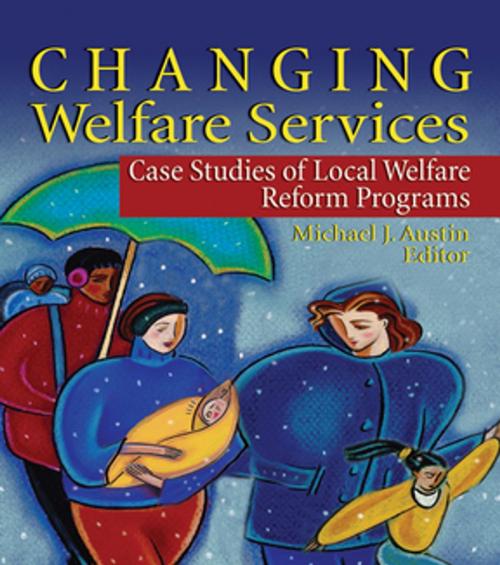Changing Welfare Services
Case Studies of Local Welfare Reform Programs
Nonfiction, Health & Well Being, Medical, Patient Care, Health Care Delivery, Social & Cultural Studies, Social Science, Social Work, Allied Health Services| Author: | Michael J Austin, Marvin D Feit | ISBN: | 9781135426378 |
| Publisher: | Taylor and Francis | Publication: | October 18, 2013 |
| Imprint: | Routledge | Language: | English |
| Author: | Michael J Austin, Marvin D Feit |
| ISBN: | 9781135426378 |
| Publisher: | Taylor and Francis |
| Publication: | October 18, 2013 |
| Imprint: | Routledge |
| Language: | English |
Contains field-tested techniques to enhance the effectiveness of your local social services!
Changing Welfare Services: Case Studies of Local Welfare Reform Programs describes promising programs and practices that have emerged in the United States since the enactment of the Personal Responsibility and Work Opportunity Reconciliation Act of 1996. Using case studies, this reference provides important lessons that will help social service directors and staff to develop strategies that will improve local welfare-to-work services. This casebook focuses on the agencies rather than the welfare population, emphasizing the guiding values of these agencies and the lessons they learned.
Changing Welfare Services explores new approaches to service delivery, with emphasis on removing barriers to work force participation and promoting self-sufficiency through support services. The case studies involve programs focused on working with the community by developing partnerships with local organizations to provide better services. This text emphasizes the organizational changes-such as the development of new training programs, merging employment and social service agencies, and restructuring agency programs to foster collaboration between child welfare services and welfare-to-work programs-that were successful strategies used to implement welfare reform.
In Changing Welfare Services, you will learn about:
- the Connections Shuttle and the Guaranteed Ride Home Program-transportation services for welfare-to-work participants
- the Exempt Provider Training Program- trains Temporary Assistance to Needy Families (TANF) participants and others to launch and improve their own high-quality child care businesses
- co-location of support services-situating mental health and substance abuse services near the social services agency so TANF participants can make a single visit for all necessary services
- the Family Loan Program-helps low-income families deal with large or unexpected one-time expenses
- the JobKeeper Hotline-provides round-the-clock counseling, crisis intervention, and referral services to help participants stay employed
- and much more!
Changing Welfare Services shows how these agencies discovered new ways to serve the needs of low-income residents and offers you a variety of inventive techniques for improving your own agency’s support for welfare recipients. Enhanced with tables, figures, and appendixes, this practitioner-oriented casebook is a much-needed complement to the many quantitative studies of the welfare population. This book is a valuable resource for state and local human service administrators and staff, policymakers, and university faculty and students of public policy.
Contains field-tested techniques to enhance the effectiveness of your local social services!
Changing Welfare Services: Case Studies of Local Welfare Reform Programs describes promising programs and practices that have emerged in the United States since the enactment of the Personal Responsibility and Work Opportunity Reconciliation Act of 1996. Using case studies, this reference provides important lessons that will help social service directors and staff to develop strategies that will improve local welfare-to-work services. This casebook focuses on the agencies rather than the welfare population, emphasizing the guiding values of these agencies and the lessons they learned.
Changing Welfare Services explores new approaches to service delivery, with emphasis on removing barriers to work force participation and promoting self-sufficiency through support services. The case studies involve programs focused on working with the community by developing partnerships with local organizations to provide better services. This text emphasizes the organizational changes-such as the development of new training programs, merging employment and social service agencies, and restructuring agency programs to foster collaboration between child welfare services and welfare-to-work programs-that were successful strategies used to implement welfare reform.
In Changing Welfare Services, you will learn about:
- the Connections Shuttle and the Guaranteed Ride Home Program-transportation services for welfare-to-work participants
- the Exempt Provider Training Program- trains Temporary Assistance to Needy Families (TANF) participants and others to launch and improve their own high-quality child care businesses
- co-location of support services-situating mental health and substance abuse services near the social services agency so TANF participants can make a single visit for all necessary services
- the Family Loan Program-helps low-income families deal with large or unexpected one-time expenses
- the JobKeeper Hotline-provides round-the-clock counseling, crisis intervention, and referral services to help participants stay employed
- and much more!
Changing Welfare Services shows how these agencies discovered new ways to serve the needs of low-income residents and offers you a variety of inventive techniques for improving your own agency’s support for welfare recipients. Enhanced with tables, figures, and appendixes, this practitioner-oriented casebook is a much-needed complement to the many quantitative studies of the welfare population. This book is a valuable resource for state and local human service administrators and staff, policymakers, and university faculty and students of public policy.















